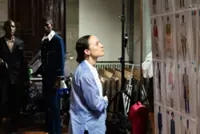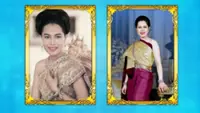From 'The Diplomat' to other political dramas, power dressing remains a cautious art. Photo: Handout
There is a scene in the second season of The Diplomat, Netflix’s smart geopolitical soap opera, in which the US vice president, played by Allison Janney, lectures the US ambassador to Britain (and would-be veep), played by Keri Russell, about her clothes.
“It’s a visual world,” Janney’s character says.
“No one will read your policy papers. Best case a sound bite will go viral once a year. Meanwhile your face will appear in the media an average of 12,000 times a day. Every classroom in America, every embassy, will hang your picture on the wall.”
So, she continues: “You’ve got a couple of choices. Wear a suit like the military wears a uniform. Disappear. Hide the individual behind the duty to serve. Or get a gimmick. Blond bob. Red lipstick. Pins like Albright, collars like RBG. Glasses. A shorthand so people see what you stand for and little girls dress like you for Halloween.”
Then she looks at Russell’s black pants, where she has placed a paper clip instead of a zipper.
“It’s best to look as though the care of your trousers wasn’t more than you could manage,” she says.
It’s about as realistic a discussion of the issue of clothes and politics as has appeared on-screen.
But in the third season – with Janney now elevated to the top job after her former boss dies of a heart attack, and Russell now second lady as well as ambassador – both women dress almost entirely in neutral pantsuits (at least when not attending black tie events).
The situation poses the question: Is this kind of reality really what we need from our on-screen female presidents?
They are, after all, the only female presidents we have. How they look in the role matters.
Read more: Volodymyr Zelenskyy does wear suits – meet the fashion designer behind his looks
Dressing the president
“Because there are no real world examples of female presidents in the US, these fictional portrayals and the societal norms they express are incredibly important,” said Meredith Conroy, a professor of political science at California State University, San Bernardino, and the author of Masculinity, Media And The American Presidency.
They may seem like mere entertainment, but they help normalise an otherwise unimaginable story line.
“It opens up your thinking,” said Lilly J Goren, a professor of political science at Carroll University in Waukesha, Wisconsin, and an editor of Women And The White House: Gender, Popular Culture, And Presidential Politics.
Indeed, according to a 2006 poll from the Kaplan Thaler Group, after the first season of the show Commander In Chief, which featured Geena Davis playing the president, of the 76% of Americans who had seen the show, 58% reported they were “more likely to take seriously the idea of a female presidential candidate”.
“The main goal was to keep things as grounded in reality as possible,” said Jenny Gering, the costume designer for the third season.
“Sometimes colour can pull focus, and it can distract. And in politics, nobody wants to alienate, offend, draw attention in that way.”
To that end, most of the seemingly plain suits worn in The Diplomat were custom-made. You can buy a piece here, or a dress there – the silky button-ups worn by Russell were by Saint Laurent and Nili Lotan; Janney wore tops by Akris and Vince and a dress from Jenny Packham that Gering further embellished.
But, tellingly, Gering felt the perfect outfit did not exist. It had to be invented.
The idea, Gering said, was that the president appear like “one of the boys".
"She’s in the room with men. She has to play on their field,” Gering added.
But shouldn’t the goal be to redefine the field instead?
Read more: 'Of steely, precise armour': Melania Trump's fashion once again under scrutiny
Breaking out of the pantsuit trap
In the real world, many women in politics have begun to stretch those notions, whether it be Angela Merkel and her brightly coloured jackets, Hillary Clinton with the white pantsuit that became a rallying cry or Kamala Harris and her pussy-bow blouses.
That the wardrobes of their fictional avatars are being reduced to their most basic common denominators is depressing.
“If you start looking at the presentation of women in power, a lot of it is done in a very masculinised way,” Goren said.
“It creates a small box. It says, ‘This is what a woman has to do to be taken seriously’.”
Conroy agreed – especially, she said, “because a lot of the fictional portrayals of women who ascend to the presidency have them doing it by default, after being vice president".
"I’d estimate that more than half – maybe 80% – of the female presidents on-screen become president by accident,” Conroy shared.
It’s as if, she said, the assumption is that the only way viewers will accept the idea of a woman president is if she has come in by the side door and “upholds these traditional notions of masculine leadership” and how it might look.
Yet, she said, “the representation of women in politics in scripted TV or film can subvert existing stereotypes. It can tell stories where the assumptions in the real world are turned on their head”.
The closest Hollywood has come recently may be Issa Rae as President Barbie in Barbie, in her pink jumpsuit and pink prom dress, or Viola Davis’s president in G20, wearing a caped red satin evening gown that gradually gets remade into a combat uniform after terrorists take over the summit dinner.
Those outfits suggest that power and femininity are not antithetical concepts (no matter how ridiculous the scenario).
Even Julia Louis-Dreyfus in Veep offered an alternative with her rainbow of sheath dresses.
Hollywood is supposed to be the dream factory. It’s the engine that stretches our imaginations and lets us envision what could be possible, because once you can envision something, you can start to expect it.
The opportunity is not merely the suggestion that a female presidency is possible. It is in suggesting, Conroy said, that a female president would “do it differently”. And dress the part. – ©2025 The New York Times Company
This article originally appeared in The New York Times.







